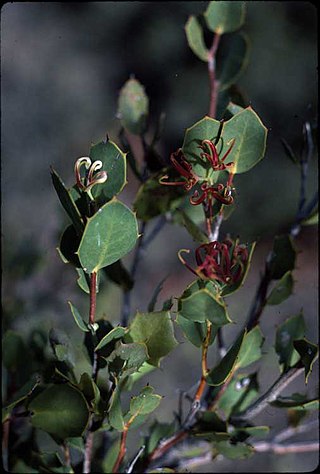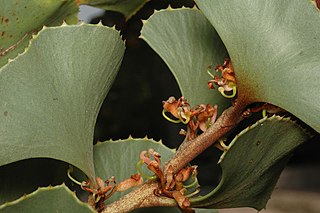
Hakea scoparia is a species of flowering plant in the family Proteaceae and is endemic to the south-west of Western Australia where it grows in shrubland. It is a shrub with ascending branches, terete leaves and clusters of cream to pinkish flowers in leaf axils from June to September.

Hakea erinacea, commonly known as hedgehog or porcupine hakea, is a shrub in the family Proteaceae endemic to south-west Western Australia.

Hakea denticulata, commonly known as stinking Roger is a shrub tree endemic southern Western Australia. One of the many species of Australian plant described by the botanist Robert Brown. A compact shrub 1–2 m (3–7 ft) high and wide with red flowers in the spring with an unpleasant odour.

Hakea cristata, commonly known as the snail hakea, is a shrub in the family Proteaceae native to Western Australia. An ornamental prickly shrub with attractive foliage and creamy white rounded flowers appearing in profusion in the winter months.

Hakea brachyptera, commonly known as the short-winged hakea, is a shrub in the family Proteaceae native to an area in the southern Wheatbelt and Great Southern regions of Western Australia.

Hakea brownii commonly known fan-leaf hakea is a shrub in the family Proteaceae native to an area in the Wheatbelt region of Western Australia. This species shares a common name with Hakea baxteri due to its distinctive leaves.

Hakea costata, commonly known as the ribbed hakea, is a shrub in the family Proteaceae native to Western Australia. A multi-stemmed small shrub producing attractive pink or white brush-like blooms rich in nectar from July to October.

Hakea cyclocarpa, commonly known as the ram's horn, wild bean or curved-fruit hakea is a shrub in the family Proteaceae. A strongly scented species with large creamy-white flowers with a red style and interesting fruit. Native to an area along the west coast and south west regions of Western Australia.

Hakea lehmanniana, commonly known as the blue hakea, is a shrub in the family Proteaceae. It has needle-shaped prickly leaves and blue flowers during winter months. It is endemic to an area in the southern Wheatbelt and Great Southern regions of Western Australia.

Hakea loranthifolia is a shrub of the family Proteaceae and is endemic to Western Australia. It has an open growth habit, stiff egg-shaped leaves with longitudinal veins, smooth grey bark and white flowers from July to September.

Hakea megalosperma, commonly known as Lesueur hakea, is a shrub of the genus Hakea native to a small area along the west coast in the Wheatbelt region of Western Australia. It is a small shrub with sweetly fragrant white or pink flowers, darkening as they age to red and thick egg-shaped bluish-green leaves.

Hakea meisneriana is a shrub in the family Proteaceae and is endemic to Western Australia. It has small, nectar rich, creamy white flowers in clusters in the upper branches from August to November.

Hakea multilineata, commonly known as grass-leaved hakea, is a shrub in the family Proteaceae. It is endemic to an area in the Wheatbelt and Goldfields-Esperance regions of Western Australia. It has pink to red long racemes in upper leaf axils and leathery linear leaves.

Hakea smilacifolia is a shrub in the family Proteaceae. It has sweetly scented flowers, stiff leathery leaves and is endemic to an area in the Mid West, western Wheatbelt and the Goldfields-Esperance regions of Western Australia.

Hakea stenophylla is a shrub or tree in the family Proteaceae, with sweetly scented creamy-white flowers. It is endemic to Western Australia.

Hakea strumosa is a shrub in the family Proteaceae endemic to an area in the Wheatbelt, Great Southern and the Goldfields-Esperance regions of Western Australia. A dense, very prickly shrub with a profusion of small, deep pink or red flowers in spring.

Hakea subsulcata is a shrub in the family Proteaceae and is endemic to an area in the Wheatbelt, Great Southern and the Goldfields-Esperance regions of Western Australia. It is an upright, broom-like shrub with needle-shaped leaves and purple-pink flowers from winter to early spring.

Grevillea cirsiifolia, commonly known as varied-leaf grevillea, is a species of flowering plant in the family Proteaceae and is endemic to the south-west of Western Australia. It is a prostrate shrub, usually with divided leaves with eight to thirty lobes, and creamy white and bright yellow flowers with a white to pale yellow style.

Grevillea hakeoides is a species of flowering plant in the family Proteaceae and is endemic to the south-west of Western Australia. It is a spreading shrub with flat, linear or more or less-cylindrical leaves and dome-shaped groups of flowers, the colour varying according to subspecies.

Daviesia hakeoides is a species of flowering plant in the family Fabaceae and is endemic to the south-west of Western Australia. It is a shrub with many tangled stems, scattered sharply-pointed phyllodes and yellow or orange and dark red flowers.





















